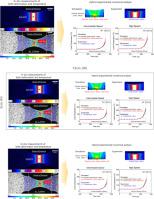International Journal of Mechanical Sciences ( IF 7.1 ) Pub Date : 2023-03-16 , DOI: 10.1016/j.ijmecsci.2023.108321 Chang Soo Lee , Jeong Whan Yoon , Sang Hyun Woo , Lee Ju Park

|
This work proposes an innovative method to analyze the softening behavior due to adiabatic heat up to the fracture onset during high-rate deformation of AISI4340 steel at room temperature. To derive the rate- and temperature-dependent constitutive equation considering the post-necking behavior, uniaxial (UT) and notched tension (NT) specimens were tested at three strain rates of 10-3/s, 100/s and 103/s. The full fields of strain and temperature were measured until fracture initiation with high-speed digital and thermal imaging cameras, respectively. In particular, this research focused on observing the abrupt localized temperature increase in the post-necking phase, which was achieved through the use of a newly configured split Hopkinson tension bar (SHTB) system. It enabled an experimental investigation of the effect of adiabatic heat on localized behavior up to fracture at high strain rates (103/s). As the strain rate increased, the strain-localization occurred more quickly, and a higher temperature was experimentally observed at the location where fracture initiated. The experimentally measured thermal field was newly utilized for inverse optimization, to determine the thermal softening effect of the constitutive model considering adiabatic heat up to the onset of fracture including post-necking. Finally, a hybrid experimental-numerical approach was used to investigate the physical quantities of local strain, strain rate, temperature inside the specimen where fracture actually began.
中文翻译:

高速变形过程中直至断裂萌生的热软化行为
这项工作提出了一种创新的方法来分析 AISI4340 钢在室温下高速变形过程中由于绝热加热导致的软化行为直至断裂开始。为了推导考虑颈缩后行为的速率和温度相关本构方程,在 10 -3 /s、10 0 /s 和 10 3 三种应变速率下测试了单轴 (UT) 和缺口拉伸( NT )试样/秒。分别使用高速数字和热成像相机测量应变和温度的全场,直至断裂开始。特别是,这项研究的重点是观察颈缩后阶段局部温度的突然升高,这是通过使用新配置的分离式霍普金森张力杆 (SHTB) 系统实现的。它能够实验研究绝热热对高应变率下断裂的局部行为的影响 (10 3/秒)。随着应变率的增加,应变局部化发生得更快,并且在断裂开始的位置通过实验观察到更高的温度。实验测量的热场被新用于逆优化,以确定考虑绝热的本构模型的热软化效果,直至断裂开始,包括后颈缩。最后,采用混合实验-数值方法研究了试样内部实际开始断裂的局部应变、应变率、温度等物理量。











































 京公网安备 11010802027423号
京公网安备 11010802027423号